From the Editor: An Outsider's Perceptions
The Gaze of Animal Life
In the News
Conducting Dog Feeding Trials on the Antarctic Huskies:
a behind the scenes look at how it got done!
Further Experiments on the nutrition of sledge dogs
How Use of the name Inuit became official
An Examination of Traditional Knowledge:
the case of the Inuit Sled Dog, part 4
Chinook Project visits Northern Labrador
Media Review: Qimmit - a Clash of Two Truths
IMHO: In Transition
Index: Volume 12, The Fan Hitch
Navigating This Site
Index of articles by subject
Index of back issues by volume number
Search The Fan Hitch
Articles to download and print
Ordering Ken MacRury's Thesis
Our comprehensive list of resources
Talk to The Fan Hitch
The Fan Hitch home page
ISDI home page
Editor-in-Chief: Sue Hamilton
Webmaster: Mark Hamilton
Print Edition: Imaged and distributed by the IPL students of the Ulluriaq School, Kangiqsualujjuaq, Nunavik
The Fan Hitch,
Journal of the Inuit Sled Dog International,
is published four times a year. It is
available at no cost online at:
https://thefanhitch.org.
Print subscriptions: in Canada $20.00, in USA $23.00, elsewhere $32.00 per year, postage included. All prices are in Canadian dollars. Make checks payable in Canadian dollars only to "Mark Brazeau", and send to Mark Brazeau, Box 151 Kangiqsualujjuaq QC J0M 1N0 Canada. (Back issues are also available. Contact Sue Hamilton.)
The Fan Hitch welcomes your letters, stories, comments and suggestions. The editorial staff reserves the right to edit submissions used for publication.
Contents of The Fan Hitch are protected by international copyright laws. No photo, drawing or text may be reproduced in any form without written consent. Webmasters please note: written consent is necessary before linking this site to yours! Please forward requests to Sue Hamilton, 55 Town Line Rd., Harwinton, Connecticut 06791, USA or mail@thefanhitch.org
Print subscriptions: in Canada $20.00, in USA $23.00, elsewhere $32.00 per year, postage included. All prices are in Canadian dollars. Make checks payable in Canadian dollars only to "Mark Brazeau", and send to Mark Brazeau, Box 151 Kangiqsualujjuaq QC J0M 1N0 Canada. (Back issues are also available. Contact Sue Hamilton.)
The Fan Hitch welcomes your letters, stories, comments and suggestions. The editorial staff reserves the right to edit submissions used for publication.
Contents of The Fan Hitch are protected by international copyright laws. No photo, drawing or text may be reproduced in any form without written consent. Webmasters please note: written consent is necessary before linking this site to yours! Please forward requests to Sue Hamilton, 55 Town Line Rd., Harwinton, Connecticut 06791, USA or mail@thefanhitch.org
The Inuit Sled Dog International
The Inuit Sled Dog International (ISDI) is a consortium of enthusiasts whose goal is the preservation of this ancient arctic breed in its purest form as a working dog. The ISDI's efforts are concentrated on restoring the pure Inuit Dog to its native habitat. The ISDI's coordinators welcome to your comments and questions.
ISDI Coordinator Canada:
Geneviève Montcombroux, Box 206, Inwood, MB R0C 1P0; gmontcombroux@gmail.com
ISDI Coordinator USA:
Sue Hamilton, 55 Town Line Road, Harwinton, CT 06791, mail@thefanhitch.org
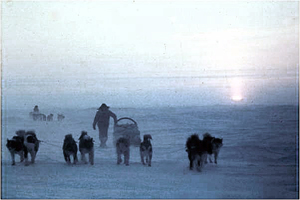
Photo: Hedges
The Gaze of Animal Life:
Memories from the British Trans-Arctic Expedition, 1968-69
by Dr. Ken Hedges
Ontario, Canada
"There is no record of a longer sustained dog-sled journey in the history of Polar exploration."
Journal of the Royal Geographical Society, December, 1970
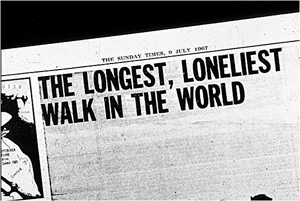
| A thousand years ago the Viking had sailed from the Old World to reach the New World. Now the four men in our crossing party were poised with our dogs, to journey on foot from the New World to the Old World across a bridge of ice extending from the shores of Alaska over the North Pole to the offshore islands of the Svalbard Archipelago. |
On Easter Day, 6/7 April 1969, four men (Sir Wally Herbert, Dr. Fitzroy 'Fritz' Koerner, Allan Gill and Major Ken Hedges) with four teams of Greenland Huskies, reached the North Pole during an expedition that would enter contemporary editions of the Guinness Book of Records as:
• The
first crossing of the surface of the Arctic Ocean;
• The first undisputed expedition to reach the North Pole on foot;
• The longest sustained dogsled journey on sea ice in the history of Polar exploration.
• The first undisputed expedition to reach the North Pole on foot;
• The longest sustained dogsled journey on sea ice in the history of Polar exploration.
The story of this expedition cannot be told until full tribute has been given to our magnificent West Greenland Huskies. Each of us was equipped with a sledge hauled by a team of ten dogs. During Christmas 1967 Allan Gill and I had purchased forty huskies at Qaanaaq, some 140 km north of the USAF Base at Thule. These wonderful animals are powerful creatures with the endurance necessary to cover vast distances (6,000 km) and able to thrive in extreme cold weather (averaging -40 degrees C) for months on end. Unlike their Alaskan counterparts, the Greenland dogs were trained to work individually using a fan hitch to reduce the loss of momentum when negotiating the rough terrain of countless pressure ridges.

Photo: Hedges
This remote land, at the northern reaches of indigenous human habitation, was an unforgiving place. In the darkness and raw cold of winter and with the encouraging companionship of local Inuit hunters, we now retraced our steps southward to Thule over an uncharted track across the Heilpren Glacier. En route, with no other means of transport in this bleak and desolate waste, we encountered a Danish school teacher who, when disoriented with hypothermia, had become separated from her party during a blizzard and sustained severe frostbite to her hands; and an impoverished young Inuit mother who had suffered disfiguring burns to her face and hands when she inadvertently added gasoline from an unmarked container to her kerosene lamp. She saved her baby from the conflagration but not without incurring considerable injury herself. They were lucky to be alive. Later, for both women there would be lifelong scars bearing evidence of their service to others.
Out here, there is an intuitive living out of a
gentler narrative:
That the needs of my neighbour best describe the coordinates of my neighbourhood.
That I am my brother’s keeper.
Out here, the human spirit, responsive to the forces of nature, discerning of the past and
creative with what lies to hand, was more clearly perceived and more often witnessed
than in the clamour of our modern suburban lifestyles with their hurried rhythms and
the pervasive appetites of a consumer society.
That the needs of my neighbour best describe the coordinates of my neighbourhood.
That I am my brother’s keeper.
Out here, the human spirit, responsive to the forces of nature, discerning of the past and
creative with what lies to hand, was more clearly perceived and more often witnessed
than in the clamour of our modern suburban lifestyles with their hurried rhythms and
the pervasive appetites of a consumer society.
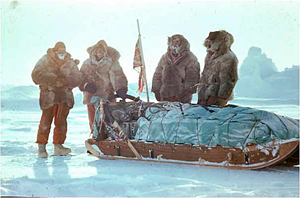
Photo: Hedges
It was a salutary prelude to the journey which lay ahead, to attempt the first crossing of the surface of the Arctic Ocean. We faced a prospect where mishap and cruel choices might dictate our very survival. Later there would be a time of prolonged social isolation to test our mettle as we lived and moved across the sea ice on a journey that would extend over 476 days. There would be unpredictable encounters with a rabid arctic fox; and half rations; and measured risks to be taken; and injuries; and predatory polar bears with the stark confrontation of kill or be killed:
Out here, in the immense silence of the Arctic,
it was the mute constancy of our dogs, our beasts of burden,
which shared and at times best conveyed the inspiring testimony of Creation.
Out here, I would come to discern that it is the gaze of animal life
which reflects the conscience of mankind
in the stewardship of nature.
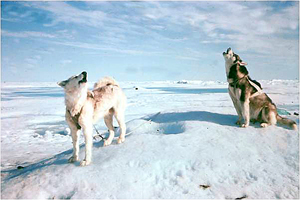
Photo: Hedges
it was the mute constancy of our dogs, our beasts of burden,
which shared and at times best conveyed the inspiring testimony of Creation.
Out here, I would come to discern that it is the gaze of animal life
which reflects the conscience of mankind
in the stewardship of nature.

Photo: Hedges
"The
gaze of animal life: Memories from the British
Trans-Arctic Expedition, 1968-1969" first appeared in
the World Wildlife
Fund-Canada blog and appears in The Fan Hitch
with the kind permissions of both Dr. Ken Hedges and
WWF-Canada." Ed.
* * *
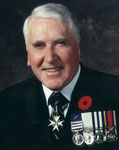 Ken spent his early childhood years in the Fiji islands.
With the
outbreak of WW2, Ken's family returned to the UK where
he completed his
schooling, graduating in 1951 from the training ship,
HMS "Worcester".
(An earlier alumnus, Lt. "Birdie" Bowers had joined
Scott of the
Antarctic and tragically succumbed with him in their
fateful return
from the South Pole in 1912.) Ken later switched careers
and graduated
from the University of Liverpool Medical School in 1962.
He served in
the Royal Army Medical Corps for twelve years
culminating in his
appointment as Senior Specialist in Public Health at
Army Headquarters,
Northern Ireland. Ken completed six operational tours
including four
with the Special Air Service (SAS). It was from the SAS
that he was
invited to join the British Trans Arctic Expedition. On
the successful
completion of the first crossing of the Arctic Ocean,
members of the
four man crossing party were invested at Buckingham
Palace with the
Polar Medal, (distinctive for its white ribbon) the
citation for which
reads: "Conferred upon those who took an active part in
an expedition
which made notable advances in the exploration of Polar
Regions and
underwent the hazards and rigours of severe conditions
in excess of 12
months."
Ken spent his early childhood years in the Fiji islands.
With the
outbreak of WW2, Ken's family returned to the UK where
he completed his
schooling, graduating in 1951 from the training ship,
HMS "Worcester".
(An earlier alumnus, Lt. "Birdie" Bowers had joined
Scott of the
Antarctic and tragically succumbed with him in their
fateful return
from the South Pole in 1912.) Ken later switched careers
and graduated
from the University of Liverpool Medical School in 1962.
He served in
the Royal Army Medical Corps for twelve years
culminating in his
appointment as Senior Specialist in Public Health at
Army Headquarters,
Northern Ireland. Ken completed six operational tours
including four
with the Special Air Service (SAS). It was from the SAS
that he was
invited to join the British Trans Arctic Expedition. On
the successful
completion of the first crossing of the Arctic Ocean,
members of the
four man crossing party were invested at Buckingham
Palace with the
Polar Medal, (distinctive for its white ribbon) the
citation for which
reads: "Conferred upon those who took an active part in
an expedition
which made notable advances in the exploration of Polar
Regions and
underwent the hazards and rigours of severe conditions
in excess of 12
months."Ken subsequently moved to Canada where he now lives in retirement just a few miles shy of 45ºN, almost exactly half way between the Equator and the North Pole!